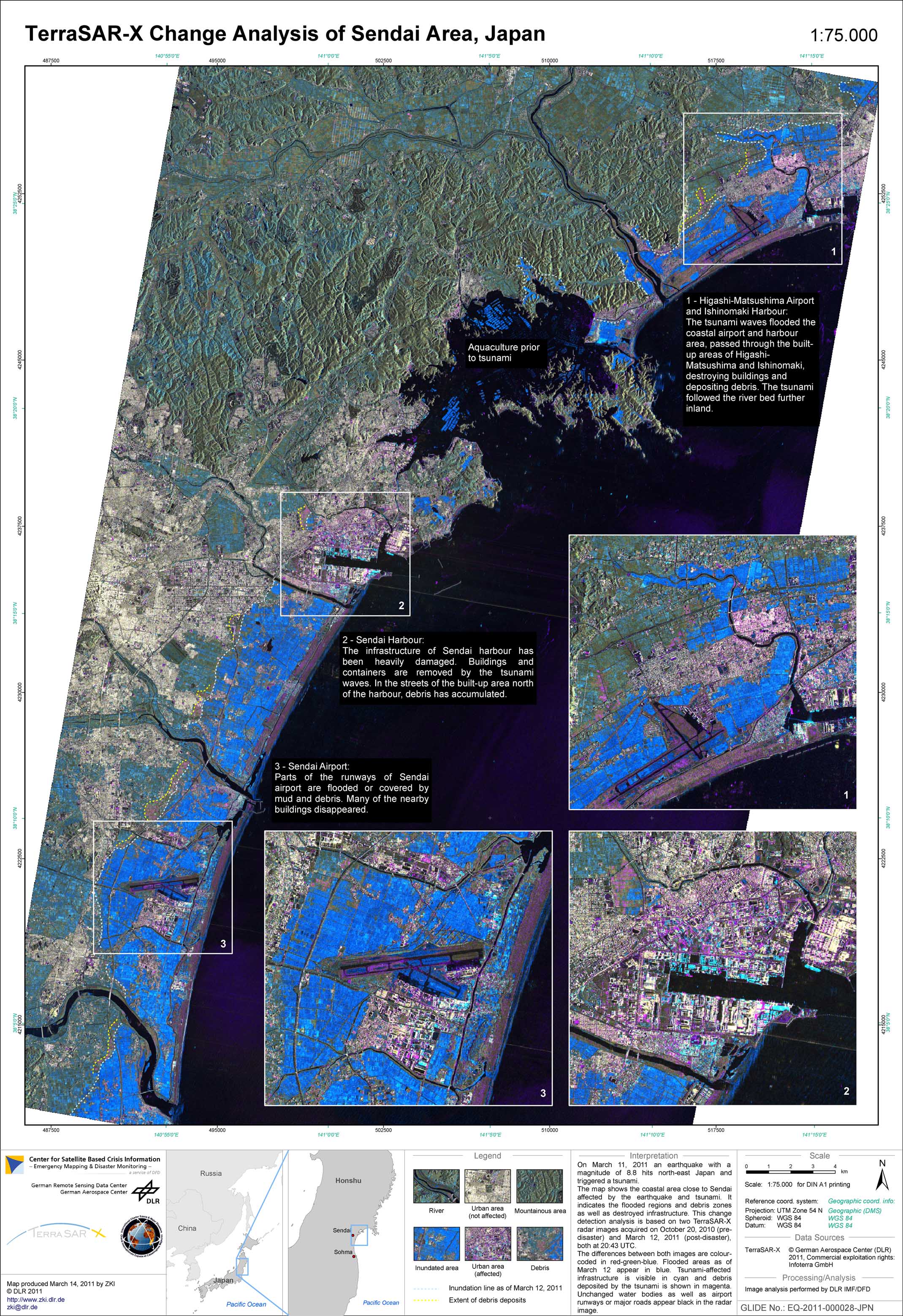[/caption]
The terribly destructive magnitude 9.0 earthquake which struck Japan on March 11, may have had another effect – Shortening the length of each Earth day and shifting its axis. Did you notice any change ?
Well according to NASA, the changes are so small that you won’t notice the difference.
Based on initial calculations conducted by Richard Gross, a research scientist at NASA’s Jet Propulsion Laboratory, the earthquake should have caused Earth to rotate just slightly faster, shortening the length of the day by about 1.8 microseconds (a microsecond is one millionth of a second), according to a statement released by NASA.
A reader posted this link to before and after photos
Gross used complex modeling and estimates of fault slippage to perform a preliminary theoretical calculation of how the earth’s rotation may have been affected.
Calculations by Gross also indicate that the position of Earth’s figure axis could have shifted by about 17 centimeters (6.5 inches), towards 133 degrees east longitude. The figure axis is the axis about which Earth’s mass is balanced.
Earth’s figure axis is therefore different and offset from the north-south axis by about 10 meters.
“This shift in Earth’s figure axis will cause Earth to wobble a bit differently as it rotates, but it will not cause a shift of Earth’s axis in space-only external forces such as the gravitational attraction of the sun, moon and planets can do that,” according to the NASA statement.
The estimates for both the shortening in the Earth’s rotation and shift in the figure axis are preliminary and will very likely change as more data is collected and the calculations are refined.
The March 11 earthquake was the fifth largest since 1900. So far, over 4000 people are confirmed dead and the overall death total may exceed 10,000.
Several heavily damaged nuclear reactors at the Fukushima plant are in danger of meltdown as hero workers inside put their lives on the line to avoid a catastrophic failure and try to prevent the spread of lethal radiation.

Previously, Gross had calculated the affects of the magnitude 8.8 Chilean quake in 2010 and found them to be slightly smaller compared to the Japanese quake. He calculated a shortening in the length of day of about 1.26 microseconds and shifting of Earth’s figure axis of about 8 centimeters (3 inches). These affects are dependent on the magnitude of the quake, exactly where it is located as well as how the particulars of how the fault slips.
In fact, Earth’s rotation is changing all the time as a result of continual changes in atmospheric winds and oceanic currents and these effects are about 550 times larger than the Japanese earthquake.
“Over the course of a year, the length of the day increases and decreases by about a millisecond,” says Gross. Indeed, the effects of earthquakes on changing rotation are so tiny that they are smaller than the margin of error in the measurements themselves.
By comparison, measurements of the figure axis are much more reliable and meaningful. Changes to the figure axis can be accurately measured to within about 5 centimeters. This means that the estimated 17 centimeter shift from the Japanese quake may be real after accounting for the effects of the atmospheric winds and ocean currents. Further research is needed as more data are collected and analyzed.
“These changes in Earth’s rotation are perfectly natural and happen all the time. People shouldn’t worry about them,” said Gross.
Source: NASA Press Release:


does the change in time however small require that the atomic clock be re-set?
The Earth Orientation Centre in Paris seems to undertake regular measurement of the Earth’s rotational period, and axis alignment.
The centre estimates that “the principal axis of inertia (or figure axis) was displaced by about 14 cm at the earth surface in the direction 135° East.”
To zoom into the TSX Datatake,
you’ll find a google kmz file under
http://www.zki.dlr.de/map/1934
Interesting article but , groan, just wait until the 2012ers and Nancy Leider’s zetas come thundering into the room with their “told you so’s” and their wild theories.
GREAT!!
Now I will have to get stuff done even faster!!
Geez, I just lost an hour to Daylight Saving Time and now this. Where and when will I ever find the time…. 🙂
Are we going to have an article like this every time we have a big earthquake? They just had all this hype about the Chilean earthquake…
Sorry, I mean a report from NASA like this… not article. The articles just report whats in the news… what needs to be controlled is someone getting a grant to copy and paste past reports and calling them new reports
No one if forcing you to read this.
Also you are assuming that people here have already read all UT articles ignoring the fact that new people never been here before see this for the first time.
It is also astronomical related.
Japan Earthquake Tsunami Satellite Photos Before & After See Photos of Disaster
We have about 500 earthquakes a week of 2.5 or more on the Richter scale. Are they all shortening the day? Do some extend it? How does one tell which lengthen and which shorten?
Chris
Zero, because years have leap-seconds to compensate deviations from logical sections. The last leap second was on 31 December 2008. For more, see the International Earth Rotation and Reference Systems Service web page on the subject
how many minutes longer would a person live then, over a lifetime?
I believe the Chilean ‘quake in the autumn had the opposite effect by lengthening the day by 1.8 milliseconds. Round and round it goes.
Yes it has shortened the Earths rotation by a very tiny amount. Another fun fact: The newly built Three Gorges Dam built on the Yangtze river in China also caused the Earths rotation to slow.
http://superprobioticsite.com/
Is The Radiation Menace Low In Japan?
http://www.newscollective.com/blog/?p=4109